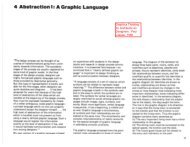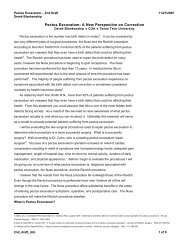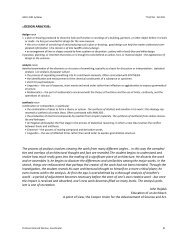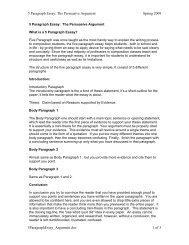The Eyes of the Skin
The Eyes of the Skin
The Eyes of the Skin
Create successful ePaper yourself
Turn your PDF publications into a flip-book with our unique Google optimized e-Paper software.
fl'om our very encounter with <strong>the</strong> world and our being-in-<strong>the</strong>-world - itis not conceptualised or intellectualised.Retinal Architecture and <strong>the</strong> Loss<strong>of</strong> PlasticityIt is evident that <strong>the</strong> architecture <strong>of</strong> traditional cultures is also essentiallyconnected with <strong>the</strong> tacit wisdom <strong>of</strong> <strong>the</strong> body, instead <strong>of</strong> being visuallyand conceptually dominated. Construction in traditional cultures isguided by <strong>the</strong> body in <strong>the</strong> same way that a bird shapes its nest by movements<strong>of</strong> its body. Indigenous clay and mud architectures in various parts<strong>of</strong> <strong>the</strong> world seem to be born <strong>of</strong> <strong>the</strong> muscular and haptic senses morethan <strong>the</strong> eye. We can even identify <strong>the</strong> transition <strong>of</strong> indigenous constructionfrom <strong>the</strong> haptic realm into <strong>the</strong> control <strong>of</strong> vision as a loss <strong>of</strong>plasticity and intimacy, and <strong>of</strong> <strong>the</strong> sense <strong>of</strong> total fusion characteristic<strong>the</strong> settings <strong>of</strong> indigenouscultures.<strong>The</strong> dominance <strong>of</strong> <strong>the</strong> sense <strong>of</strong> vision pointed out in philosophicalthought is equally evident in <strong>the</strong> development <strong>of</strong> Western architecture.Greek architecture, with its elaborate systems <strong>of</strong> optical corrections, wasalready ultimately refined for <strong>the</strong> pleasure <strong>of</strong> <strong>the</strong> eye. However, <strong>the</strong> privileging<strong>of</strong> sight does not necessarily imply a rejection <strong>of</strong> <strong>the</strong> o<strong>the</strong>r senses,as <strong>the</strong> haptic sensibility, materiality and authoritative weight <strong>of</strong> Greekarchitecture prove; <strong>the</strong> eye invites and stimulates muscular and tactilesensations. <strong>The</strong> sense <strong>of</strong> sight may incorporate, and even reinforce,o<strong>the</strong>r sense modalities; <strong>the</strong> unconscious tactile ingredient in vision isparticularly important and strongly present in historical architecture, butbadly neglected in <strong>the</strong> architecture <strong>of</strong> our time.Western architectural<strong>the</strong>ory since Leon Battista Alberti has been primarilyengaged with questions <strong>of</strong> visual perception, harmony and proportion.Alberti's statement that 'painting is nothing but <strong>the</strong> intersection<strong>of</strong> <strong>the</strong> visual pyramidfollowing a given distance, a fixed centre and acertain lighting' outlines <strong>the</strong> perspectival paradigm which also became<strong>the</strong> instrument <strong>of</strong> architectural thinking.45 Again, it has to be empha-in. d [hat <strong>the</strong> conscious focusing on <strong>the</strong> mechanics <strong>of</strong> vision did notsls~OJ11atiCallyresult in <strong>the</strong> decisive and deliberate rejection <strong>of</strong> o<strong>the</strong>rau seS before our own era <strong>of</strong> <strong>the</strong> omnipresent visual image. <strong>The</strong> eyesen tiers its hegemonic role in architectural practice, both consciouslyan co:qtlnconsciously, only gradually with <strong>the</strong> emergence <strong>of</strong> <strong>the</strong> idea <strong>of</strong> abo d'I"sS 1 "'- observer. <strong>The</strong> observer becomes detached from an incarnaterelation with <strong>the</strong> environment through <strong>the</strong> suppression <strong>of</strong> <strong>the</strong> o<strong>the</strong>rsenS es in particular by means <strong>of</strong> technological extensions <strong>of</strong> <strong>the</strong> eye, and-,<strong>the</strong> proliferation <strong>of</strong> images. As Marx W Wart<strong>of</strong>sky argues, '<strong>the</strong> humanVIS10.. n is itself an artifact, produced by o<strong>the</strong>r artifacts, namely pictures'.46<strong>The</strong> dominant sense <strong>of</strong> vision figures strongly in <strong>the</strong> writings <strong>of</strong> <strong>the</strong>modernists. Statements by Le Corbusier - such as: 'I exist in life only ifI can sec';47 'I am and I remain an impenitent visual - everything is in<strong>the</strong> visual';48 'One needs to see clearly in order to understand';49 ' ... IurgC YOU to openyour eyes. Do you open your eyes? Are you trained too en your eyes? Do you know how to open your eyes, do you opent:crn <strong>of</strong>ten, always, well?';50 'Man looks at <strong>the</strong> creation <strong>of</strong> architecturewitb bis eyes, which are 5 feet 6 inches from <strong>the</strong> ground';51 and,'Arcbitecture is a plastic thing. I mean by "plastic" what is seen andmeasuredby <strong>the</strong> eyes,52- make <strong>the</strong> privileging <strong>of</strong> <strong>the</strong> eye in early modernisttbeory very clear. Fur<strong>the</strong>r declarations by Walter Gropius - 'He[tbe designer] has to adapt knowledge <strong>of</strong> <strong>the</strong> scientific facts <strong>of</strong> opticsand tbus obtain a <strong>the</strong>oretical ground that will guide <strong>the</strong> hand givingsbape, and create an objective basis'53 - and by Laszlo Moholy-Nagy'Tbe bygiene <strong>of</strong> <strong>the</strong> optical, <strong>the</strong> health <strong>of</strong> <strong>the</strong> visible is slowly filteringthrough'54 - confirm <strong>the</strong> central role <strong>of</strong> vision in modernist thought.Le Corbusier's famous credo, 'Architecture is <strong>the</strong> masterly, correctand magnificentplay <strong>of</strong> masses brought toge<strong>the</strong>r in light',55 unquestionablydefines an architecture <strong>of</strong> <strong>the</strong> eye. Le Corbusier, however, was agreat artistic talent with a moulding hand, and a tremendous sense <strong>of</strong>materiality, plasticity and gravity, all <strong>of</strong> which prevented his architecturefrom turning into sensory reductivism. Regardless <strong>of</strong> Le Corbusier's26THE EYES OFTHE SKINPART I 27
















